Parents are often wondering, “When can babies eat cheerios?” Or, puffs, toast, cheese, watermelon, and banana. Learn when so you can feed your baby safely!
Affiliate links used below. See our full disclosure.
When I was a first-time mom, I was ecstatic when it was time to start feeding my son real food. Since I’d fed a lot of other babies as a feeding therapist, I knew that first foods matter, but as a mom I was also a little nervous.
Even though my son was gobbling down smooth baby food, I wasn’t quite sure what he’d do the first time he had food that he actually had to chew before swallowing. He could gag, which is common. See our guide to baby gagging for more info on how to handle gagging.
Or worse, he could choke. Would I remember how to do the CPR training that I’d been certified to do correctly?
Fortunately, while my mommy brain was in overdrive, my occupational therapist brain knew that it wouldn’t help him learn to eat if I just waited until I felt 100% comfortable to start giving him puffs, cheerios, or other new foods that we tend to wonder if our babies can handle safely.
What most parents don’t know is that there’s an ideal time to feed your baby cheerios or puffs.
The key is knowing when so that you can confidently give your baby the foods you’re so excited (and nervous) to start feeding them. Let’s dive into the foods that you’re wondering about the most…
When Can Babies Eat Cheerios?
Cheerios are the quintessential finger food for baby, they were in large part the first and most common food that my generation was given as young babies and toddlers.
And, while cheerios are still appropriate, there are a few things you’ve got to know first.
As a pediatric OT, cheerios are NOT the first finger food I recommend that parents give their baby.
While they are great for being picked up easily, they don’t dissolve quickly, like many other dry cereals. Ideally, a baby should munch up and down to mash up the cheerio, either with their gums or emerging teeth.
If a baby doesn’t mash up the cheerio well, it can take a long time to dissolve for safe swallowing.
That means that if your baby doesn’t have solid chewing skills, and many don’t, they could gag or choke on a cheerio. It doesn’t matter if it’s regular cheerios, honey nut cheerios, or apple cinnamon cheerios.
Babies that are hitting other feeding milestones on time can usually eat cheerios sometime between 9-12 months of age.
When exactly in that 3 month range, all depends on what other finger and table foods your baby is already eating. Long before they have cheerios, I want to make sure babies can eat foods that dissolve quickly like graham crackers and puffs.
I also want babies to be able to eat some soft foods well too. Occasional gagging is normal, but persistent gagging that gets in the way of your baby being able to eat is an indicator that they aren’t ready to eat cheerios yet.
To sum it all up… These are 4 signs your baby may be ready to eat cheerios:
1.Are typically in between 9-12 months old
2. Already safely eating a variety of other foods well
3. You witness their jaw munching up and down when they eat other foods
4. Can pick up the cheerios with a pincer grasp (an important fine motor skill when baby isolates their index finger and thumb to pick it up). If your baby needs help developing this check out how to teach your baby to self-feed.
*Learn 5 Big Mistakes that Parents (Unknowingly) Make When Feeding Their Baby or Toddler Table Foods in my free workshop. And, learn what to do to help them eat well!*
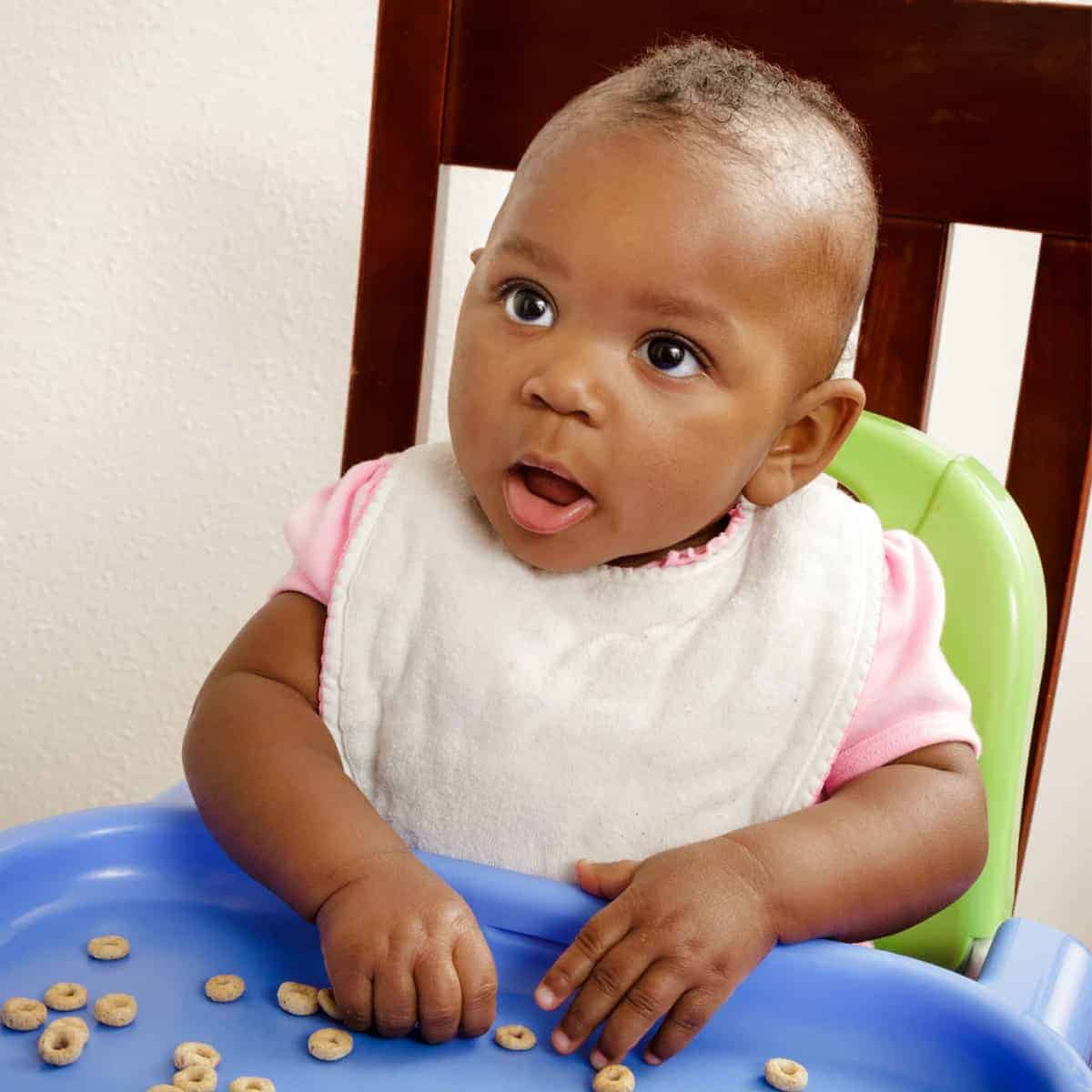
When Can Babies Eat Puffs?
Puffs are my preferred very first finger food for baby as they transition from only breastmilk or formula, and are available in a wide range of different brands.
For those of you following a Baby Led Weaning (BLW) approach, that will contradict what you’ve learned about baby’s first food. You can read why I think puffs are a great to start with in Pros and Cons of BLW.
I have given puffs to all three of my children as their very first finger food around 7-8 months old, but your child may not be ready until around 9 months old.
Again, more important than the age, are signs that they are ready. Here’s how you’ll know when your baby can eat puffs:
-
- Able to sit independently
-
- Demonstrates munching up and down either when watching you eat, on teethers, or their baby food
-
- Usually between the ages of 7 and 9 months, although it varies
If you’re skittish about starting your baby on puffs, it’s always a good idea to talk to your pediatrician first. One of the benefits of puffs, and why I love them for babies, is because they dissolve fast in saliva in your baby’s mouth.
That means if your baby tries to eat it and doesn’t know what to do, it will melt into a goo and they can swallow with little effort.
Want a whole guide on how to introduce your baby, step by step, to table foods? Believe it or not, you don’t have to go straight to infant cereal or rice baby cereal. Head over to How to Introduce Table Foods to Babies and Toddlers.
When Can Babies Eat Toast?
Another classic finger food for babies is toast!
Toast is a great food to give babies and it’s easy to top with lots of healthy and different spreads. Think avocado, cream cheese, or even peanut or nut butter as a healthy breakfast option.
(Yes, babies can have nut butters, it’s actually a great way to introduce common allergens early on, but double check with your doc’s advice and spread it thin.)
Like cheerios, toast also requires some more chewing, which means your baby has to have some skills.
Toast cut into squares, small pieces, or strips are great for babies that are managing puffs, graham crackers, and soft foods like cubed avocado well.
This is usually around 9-12 months old. When you do, give your baby toast for the first time, look for them to be chewing well with a clear up and down motion.
When Can Babies Eat Grapes, Blueberries, and Cherry Tomatoes?
Small round foods can be a serious choking hazard, but when they are cut in half (blueberries) or quartered (grapes and cherry tomatoes), babies are able to pick them up with little fingers and eat them safely also around 9-12 months old with a lower risk of choking.
The skin on cherry tomatoes and grapes can be a little tough, and some parents prefer to skin them.
Your baby will likely be ready to handle these foods when they are eating a variety of different textures and a variety of foods, but it may be hard for them to pick up, which may mean you’ll have to wait a little longer.
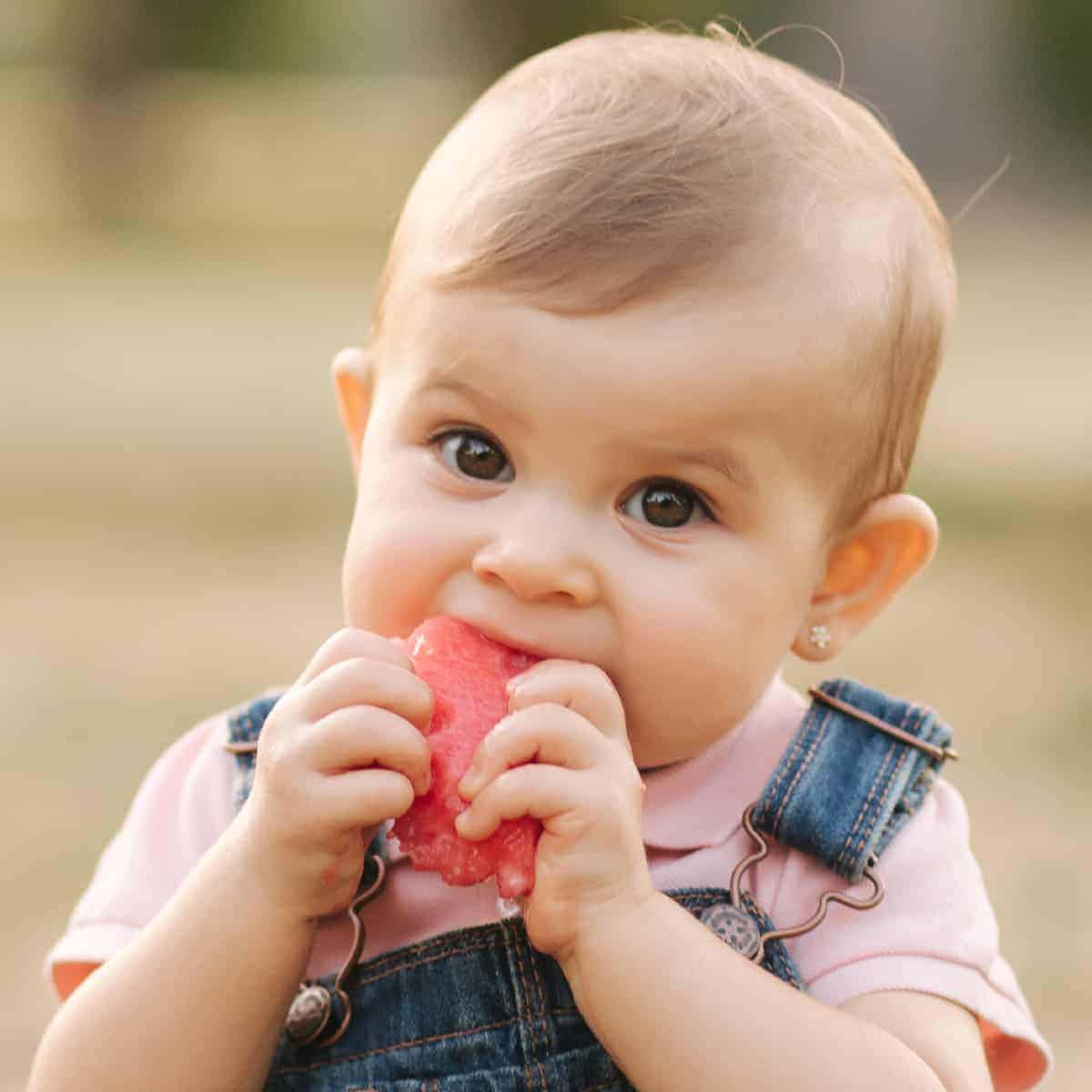
When Can Babies Eat Watermelon?
This is another one of my favorite first finger foods for babies, right after they’ve mastered those graham crackers and puffs. Cut the watermelon into small cubes and watch with delight as the juice runs down all over their adorable little chin.
Babies can often start eating watermelon between 7-10 months old, and they are great for self feeding, as babies and young children love the flavor. They’re great for hydration too!
When Can Babies Eat Banana?
Once babies are eating watermelon well, they can often handle banana as a general rule. Just keep a lookout that the pieces aren’t too big for baby’s mouth or that they aren’t showing too much food into their mouth at once because banana can clump together.
Bananas are often thought of as a good choice for a first finger food because it’s soft and babies can chew it easily, but sometimes it’s too mushy they can lose track of it and not chew it well. That’s another reason I like starting out with crunchy foods that melt first.
Look for your baby to manage bananas around 7-10 months old. You may even want to try this healthy banana pumpkin bread recipe!
When Can Babies Eat Cheese?
Cheese is obviously dairy and it seems contradictory that babies can eat it when they aren’t allowed cow’s milk until age 1, but the protein structure is different so pediatrician’s give it the green light before 12 months old.
Cheese that’s a bit softer, like from mozzarella, is a great starting place and makes a delicious snack that many kids love, even in the first year of life.
When your baby is eating melt-able crackers, watermelon, and banana without frequent gagging and with a munching up and down, they are often ready to handle cheese that’s cut into cubes.
This is usually around 8-10 months old.
My Favorite First Table Foods for Babies
Knowing what other foods you can give your baby can seem daunting, which is why I have an awesome Mega List of First Table Foods for you, and as your baby is getting a little older a Baby and Toddler List of Meal Ideas.
Not to mention that you can also snag up a handy printable with many of the ideas to stick on your fridge for quick reference!
It will be important to offer a variety of first finger foods, beyond just puffs, some of my favorite are:
-
- Plum Organics Teething Wafer
- Lil’ Crunchies Baked Corn Snack (think a vegetable cheese curl)
- Happy Baby Yogurt Melts
- Happy Baby Rice Husks
Tips for Giving Your Baby Food for the First Time
There are a couple of misconceptions floating around out there about when and how to feed your baby, especially as you’re giving them foods for the very first time. I want to debunk a couple of those myths so you can feel good about teaching your baby how to eat:
-
- Babies DO NOT need teeth to eat – Sure, if your 9 month old were having a steak, some molars might come in handy, but babies were designed to use their powerful gums to plow through all the foods you found listed here and many more.
- Gagging is normal – Gagging and choking are two different things. Gagging happens when a food hits their gag reflex, when they weren’t expecting it to. Most of the time, they recover the food and are able to swallow or spit it out.
Also, some gagging occurs as a response to a texture, taste, or smell they don’t like. That has to do with sensory aversions to food.
-
- If they aren’t eating, just wait, they’ll grow out of it – Unfortunately, this is sometimes the advice given by professionals. As a feeding therapist, I’ve seen small issues snowball into something much bigger many times. If you have any doubts head to feeding therapy information on how to get some professional help.
Lastly, remember to be patient. You may feel edgy and anxious as you watch those first bites and tastes. Giving your baby finger foods is a transition that takes time. Some meals won’t go well, that’s okay.
Remember that generally, you have time to work on these skills, and every kid develops at their own rate. We are here to help you navigate the journey with your child.
Have more questions?? Ask them in the comments… we answer every single one!
Don’t Forget Your Free Printable
Now that you’ve got a great guideline on when to start your baby on different foods, make sure you grab your free printable with a huge list of table food ideas and meals that are specifically designed for babies and toddlers! Get it here.
More on Feeding Babies
What to Do When Baby Won’t Eat Solids: 7 Simple Steps
Ultimate List of Mealtime Must-Haves for Baby
Introducing Baby Food: Everything You Need to Know
Did you pin this?
You’ve got to admit this is some important stuff. Pin this on your baby or parenting board so you can reference it later!
Alisha Grogan is a licensed occupational therapist and founder of Your Kid’s Table. She has over 19 years experience with expertise in sensory processing and feeding development in babies, toddlers, and children. Alisha also has 3 boys of her own at home. Learn more about her here.
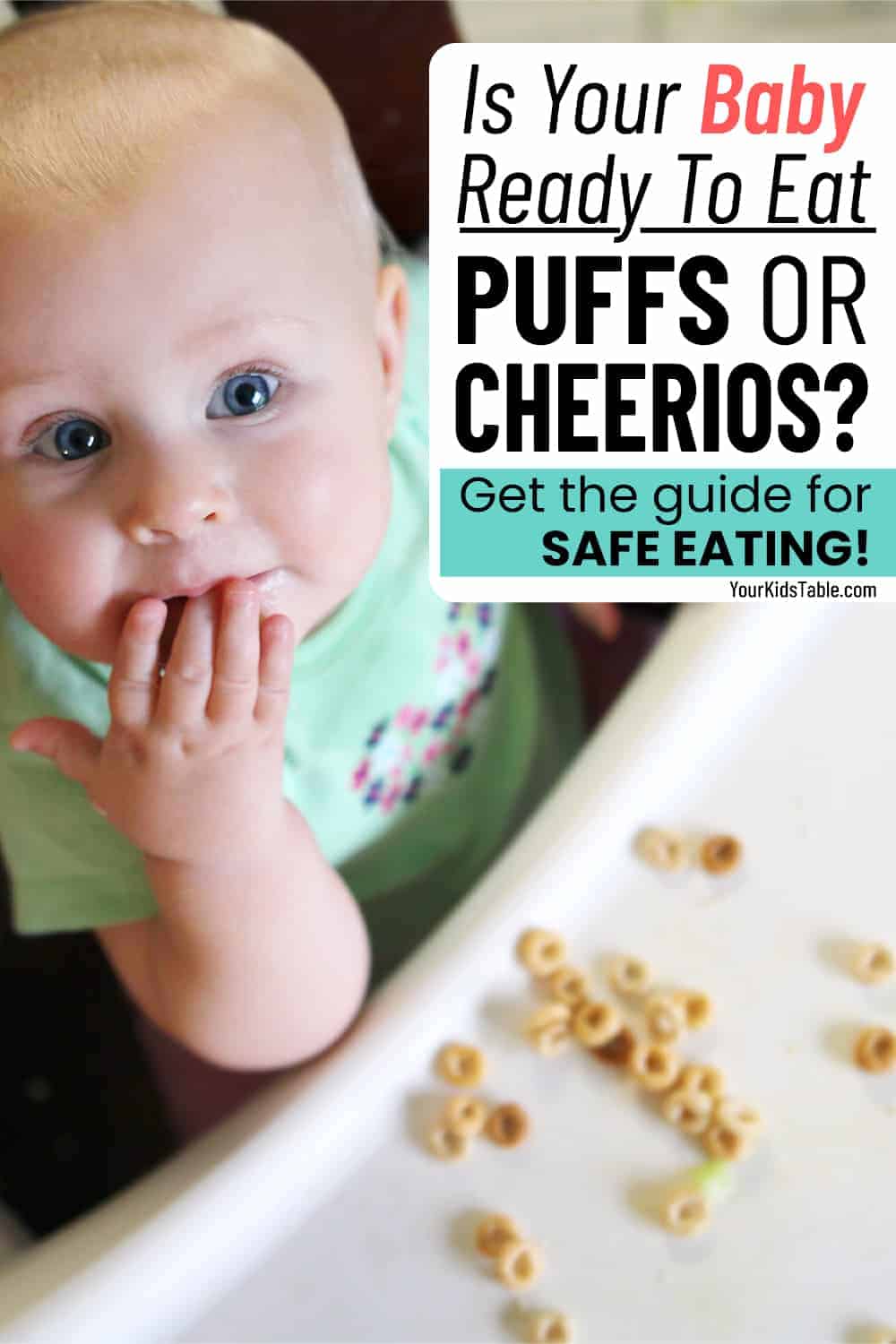
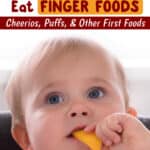
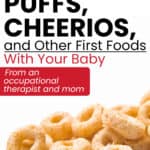
My daughter is 9 months . My partner gives her those orange wotsits and monster munch snacks at meal times . Sometimes before a meal and during. She’s wanting the snacks .
Are these harmful?
Hi Maria! Thanks for reaching out! If she doesnt have any issues with chewing/swallowing those snacks, then they aren’t necessarily “harmful,” especially in moderation! You can also try baby puffs, since they have the same texture but contain less sodium. Hope that helps!
Best,
Kalyn
This article was very informative! My little one is 10 months old and eats tons of table foods well, however I cut them small; I had read you should make them smaller than your pinky fingernail. When do you know to transition to bigger pieces, or what size cubes are you suggesting? I know she eventually should be able to make her own bites but I’m confused on when! For example, with bagels and tortillas.
Hey Katie,
So glad you found some great information!! So happy your little one is enjoying a variety of foods. You can definitely transition to the longer pieces, I’d start with things like toast and just cut it in strips to provide her a piece for holding and bringing to her mouth. This will be great practice for biting and chewing.
Best,
Desiree
My baby is four months old and can sit up on his own for a the most part he is interested in food but I’m not sure if I should start feeding him baby food?!?
Hey Christina,
Thanks for reaching out! You are hitting on some very important points. We do recommend that a baby can sit with little to no assistance, be interested in foods and is at least 4 months. Most Feeding therapists will say to wait until 6 months as the digestive tract is more developed and food is absorbed better as well as the child is able to sit supporting themselves more. However if your pediatrician is telling you to start, I’d go over reasons for starting early and make your decision. Here is an ARTICLE that goes more into detail to help with your decision.
Best,
Desiree
Thank you so much for this post, I’ve been having so much anxiety about transitioning my baby from purees to finger foods and I love how nicely you explained things!
You are so welcome!! So glad we can help!
Hii!
So I started my baby on purées around 6 months.
Since he turned 9 months this week he started to refuse eating from the spoon/closes his mouth and turns his head.
Is this normal?
At one point he was clearing all his food now after one spoonful he won’t open his mouth for more.
He has no problem drinking his formula.
Any suggestions? Should I start regular food? Just nervous with choking.
Thank you!
Hi Briana! Thanks for reaching out! What a fun time for both you and baby right now exploring solids! It could be that he’s bored with purées and may be ready for solids and different textures! Or he may even be wanting to feed himself! Try giving him a spoon of his own that has been dipped in a little bit of puree while also having your own spoon. You can take turns doing the feeding. It might be messy, but this is a great step towards their independence! Try introducing some other solids and see if he is interested. Do this without pressure- allowing him to touch/feel/play with his food and feed himself how much he wants to eat, without any pressure. We have a guide here that might be helpful, especially since you’re concerned about choking- which is a valid fear! Hope that helps!
Best,
Kalyn
My son will be 8 months on the 24th. In the last few days, I have tried to feed my son the puffs and at first, he did okay with them. But now he has been choking on them and I have to put my finger in his mouth to get the puffs out. I thought he would do okay with them but I guess not.
Hey Angel,
We get it and know the feeling! The nice things about puffs is that they do dissolve so it is a great learning tool. You can wait and try in a couple more days, or try breaking them in half to see how he does. If you still feel like you need more help you can watch our free workshop! You will learn different things to do/try and when to try them as well as how to help them along! You can Save Your Seat Here
Best,
Desiree
Thanks for the great article! My 9 month old eats some table foods (scrambled eggs, shredded cheese, avocados, bananas, quartered blueberries) but I don’t feel confident giving her bread (because it clumps up in mouth) or more than one puff at a time. She also stuffs foods in her mouth, which makes me nervous. She handles most of the table food fairly well when she stuffs her mouth, but not the puffs. And even if I give her one puff, she may still gag on it. Not all the time but at least once each time I serve them. I’m not sure what to do at this point and how to keep serving the puffs.
Hey Jennifer! Sounds like you are doing a nice job with getting some variety of foods offered to your little one! I can understand getting nervous on gagging, as it can be hard, but this is part of the feeding learning process. I’d recommend looking at this article on transitioning to table foods! It has more step by step with understanding how to move through the foods! https://yourkidstable.com/how-to-transition-your-baby-or-toddler/
Best:)
Desiree
Your Kids Table Team Member
My son just turned 11 months old. He eats a number of table foods like scrambled eggs, cottage cheese, banana, avocado, whole wheat waffles, etc.. However, many times he will gag and throw up (most often on puffs that get stuck in the back of his throat). When you mention concerns about a child who gags often, what do you consider often? My pediatrician said it’s normal and I shouldn’t be concerned, but I am.
If he has thrown up from gagging more than 2 times, I’d think there was something going on that he needed some more help with. If he’s just gagging once a day or 4-5 times a week, I’d also think the same. You can head to how to transition to table foods for some specific tips and a free printable to help!
Hello, informative article on what is appropriate for babies to eat. I’m a little surprised to see an emphasis on puffs and other processed baby snacks, there’s so much sugar and oil and additives in these products that babies should not be consuming, as well as excess packaging. Please consider suggesting healthy alternatives! Thank you. (I’ve been doing BLW and offer my baby plain unsalted organic rice cakes, I’m guessing that’s a good option?? She loves them.)
Hi Laurie,
So happy you found some great information in the article. While we do understand about the processed baby snacks and what they contain, these items ie: puffs are very helpful for a child to learn how to chew. These items are meant to melt in their mouths, so they are learning where they are in their mouth and how to move them around. We are so happy that BLW is working for you, some other kids just need more help before getting to those other foods to chew!!
Best,
Desiree
My LO is 10mo today. We started with BLW at 6months and it went well (the occasional expected gagging) at around 9mo I started giving her table food cut into pea/chickpea sized pieces. She eats this without any trouble. Yesterday I gave her a big piece of avocado (two fingers wide) She took one giant bite and swallowed. It got lodged in her throat and I had to get her out her chair. It came out as soon as I turned her over but you can imagine that it gave me quite a fright. After that, I gave her sliced strawberries and I observed closely. She seems to move them around in her mouth but I don’t see any up and down movement on her jaw. I’ve concluded that she doesn’t chew her food! I assume in the past when she was eating strawberries and toast etc that she was taking smaller bites and swallowing. I don’t know how to move forward. Do I continue cutting up table food and she will eventually figure it out or do I go back to BLW 101 and give her giant pieces with the risk of her biting off big pieces and attempting to swallow them whole? We have only tried whole foods. She hasn’t had any processed products so we haven’t tried puffs etc. I would appreciate your thoughts on the matter. Thank you
Hi Monique,
This is a scary experience and I can see how it would make you considering changing things up for safety. It is definitely possible that she is not chewing and has so far gotten “lucky” with just swallowing. Have you read this article on encouraging oral motor skills? Start there, and I think cutting up table food and using big pieces that cannot be swallowed will help. If you continue to have issues with her chewing, we have a few other articles on building these skills, but start there first and let us know how it goes.
Best,
Laura
Your Kid’s Table team member
Thank you so much for all this helpful information! I have a question about toast. After reading this, I double checked the ingredients in the wheat bread and other breads (and graham crackers) we typically buy, and they all list honey as an ingredient. I can’t find a definitive answer online about whether honey in commercial baked goods is safe for babies under age 1. Is the toxin definitely killed off in store bought baked goods?
Good question, that is my understanding and I used them, but I’d check with your doctor. Mine told me they were safe if baked.
Excellent articles…thank you..i search everywhere for information to help me with this issue. Yours is the first to give me some good ideas and Hope!
I’m so happy you found your way here and that the information was helpful!
I’m curious your thoughts on baby led weaning?
Oh, I have a whole post on that. Check it out here:)
Just wanted to say thank you for all of this helpful information. I appreciate this resource!
Thanks Marie, I’m so glad it was helpful!
Hello Alisha!
While this doesn’t apply to eating for babies, I would like to know at what age is it safe for a toddler to eat popcorn? I have heard several different answers and feel like popcorn is the new hot dog in terms of choking hazards. Thanks!
That’s such a good question and the reason its hard to get a good answer is that it varies depending on what you’re reading. I think a child should be at least 3 years old, you could wait till 5 though. I also try to reinforce taking just a few pieces, sitting at the table, chewing well, etc. 🙂
Hi, my baby is 14 mo and still not doing really good with solids. When, i gave her finger food (omelet, cheerios, puffs, etc), she just swallow them without chewing. Also, when she’s eating soft things like pasta, soft vegetables, pancake, she just chew a little bit between her tongue and palate and swallow it, she barely gag. I try to show her how to chew but no success yet. Do you have any advice? Doesn’t look like she has a tongue thrust or something like that. Thank you
Hi Joanie,
We have a free workshop on transitioning to solids that may help. Here is also an article on chewing that may be helpful.
Best,
Laura
Your Kid’s Table team member